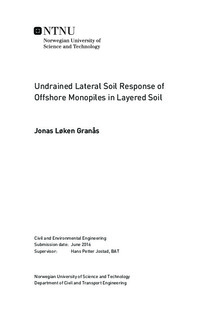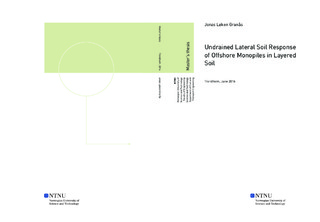| dc.description.abstract | Finite Element analyses (FEA) may give coupling between soil layers with different properties when it comes to lateral response of an offshore monopile. The common design recommendation API Recommended Practice (API-RP), uses the p-y method, which idealizes the soil as a series of uncoupled springs along the pile. Consequently, the interaction between soil layers is left out in the analysis. In addition is the initial stiffness of the soil response in API-RP formulated with a linear response up to 23 percent mobilization of the maximum undrained lateral resistance.
Soil coupling effects between soil layers of different stiffness and initial lateral stiffness have been investigated for a monopile in undrained clay through FE analyses using Plaxis 3D. The results have been compared with the API-RP when reasonable.
Both linear elastic soil and non-linear soil were considered, using NGI-ADP for the latter. Vertical aspects were neglected. The monopile was assigned a high stiffness, behaving effectively as a rigid body. Pile diameter and length were 5m and 35m respectively.
As an initial study, a homogeneous soil profile was considered. The FE simulations did show slight mode dependency. The normalized lateral stiffness, p/(yG)=k_h/G, at depth of assumed plane strain conditions was found too soft compared to analytical solution. This was unexpected as FEA tend to give stiffer responses. The reason for this was not found.
The same simulation results were used in order to relate it with the initial lateral soil stiffness given in API-RP. Several assumptions were made in addition to involvement of fitted tau - gamma curves from a real soil. The results suggested that conducting a linear elastic FE simulation with G_max as input will give stiffer response than predicted by API-RP.
For the non-linear FE analysis, the initial lateral stiffness was calculated as a secant stiffness corresponding to the initial stiffness formulation given in API-RP. The results were then compared with the initial stiffness given in API-RP. The results suggested that the API-RP predicts too stiff behaviour for OCR=1 clay, whereas too soft for OCR=4 and OCR=40.
Further was linear elastic soil with layering investigated. An intermediate layer and a two layer system was investigated in a simple framework. The main objective was to demonstrate presence of soil layer interaction. This was successfully demonstrated. However, it turned out that some of the results were hard to explain.
The most extensive analysis comprised coupling effects in a two layer system with non-linear soil and provided the main findings. The two layers were assigned equal soil parameters only distinguished by a higher s_u for the bottom one. It follows that s_u determined stiffness as the G_max/s_u-ratio was equal for both layers. It was found that the soft layer became stiffer with increasing s_u- ratio and vice versa. However did results suggest a distinctive difference in behavior between the layers in the sense that the soft layer above turned stiffer from initial mobilization, with a relatively less significant response with increasing mobilization. The influence zone increased slightly with increasing s_u-ratio, but was reduced slightly with increased mobilization. Whereas the stiffer layer below appeared almost unaffected at initial mobilization, but with a relatively more significant response with increasing mobilization. Hence was also the influence zone approximately zero at initial mobilization, but increased notably with higher mobilization. It was unclear how the s_u-ratio affected the influence zone for the bottom layer.
Based on the results, it is difficult to state whether the API-RP formulation of initial stiffness has weaknesses. There are too many assumptions in the calculations. However does the fact that the API-RP is based on investigations of piles with prominently different geometry call for a re-investigation of the formulation.
Coupling effects were demonstrated, proving the p-y-method inadequate. However, based on the findings, it is perhaps possible to incorporate some of the effects into the p-y-method for simple soil profiles. The condition must be that it is easy to use, so that it gets applied in engineering design. | |

